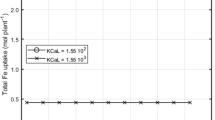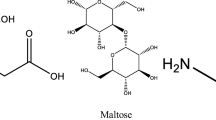Abstract
It has been frequently suggested that root exudates play a role in trace metal mobilization and uptake by plants, but there is little in vivo evidence. We studied root exudation of dicotyledonous plants in relation to mobilization and uptake of Cu and Zn in nutrient solutions and in a calcareous soil at varying Cu and Zn supply. Spinach (Spinacia oleracea L.) and tomato (Lycopersicon esculentum L.) were grown on resin-buffered nutrient solutions at varying free ion activities of Cu (pCu 13.0–10.4) and Zn (pZn 10.1–6.6). The Cu and Zn concentrations in the nutrient solution increased with time, except in plant-free controls, indicating that the plant roots released organic ligands that mobilized Cu and Zn from the resin. At same pCu, soluble Cu increased more at low Zn supply, as long as Zn deficiency effects on growth were small. Zinc deficiency was observed in most treatment solutions with pZn ≥ 9.3, but not in nutrient solutions of a smaller volume/plant ratio in which higher Zn concentrations were observed at same pZn. Root exudates of Zn-deficient plants showed higher specific UV absorbance (SUVA, an indicator of aromaticity and metal affinity) than those of non-deficient plants. Measurement of the metal diffusion flux with the DGT technique showed that the Cu and Zn complexes in the nutrient solutions were highly labile. Diffusive transport (through the unstirred layer surrounding the roots) of the free ion only could not explain the observed plant uptake of Cu and of Zn at low Zn2+ activity. The Cu and Zn uptake by the plants was well explained if it was assumed that the complexes with root exudates contributed 0.4% (Cu) or 20% (Zn) relative to the free ion. In the soil experiment, metal concentrations and organic C concentrations were larger in the solution of planted soils than in unplanted controls. The SUVA of the soil solution after plant growth was higher for unamended soils, on which the plants were Zn-deficient, than for Zn-amended soils. In conclusion, root exudates of dicotyledonous plants are able to mobilize Cu and Zn, and plants appear to respond to Zn deficiency by exuding root exudates with higher metal affinity.







Similar content being viewed by others
References
Amery F, Degryse F, Degeling W, Smolders E, Merckx R (2007) The copper-mobilizing-potential of dissolved organic matter in soils varies 10-fold depending on soil incubation and extraction procedures. Environ Sci Technol 41:2277–2281
Cakmak I, Marschner H (1988) Increase in membrane permeability and exudation in roots of zinc deficient plants. J Plant Physiol 132:356–361
Cakmak I, Sari N, Marschner H, Ekiz H, Kalayci M, Yilmaz A, Braun HJ (1996) Phytosiderophore release in bread and durum wheat genotypes differing in zinc efficiency. Plant Soil 180:183–189
Cattani I, Fragoulis G, Boccelli R, Capri E (2006) Copper bioavailability in the rhizosphere of maize (Zea mays L.) grown in two Italian soils. Chemosphere 64:1972–1979
Chaignon V, Di Malta D, Hinsinger P (2002) Fe-deficiency increases Cu acquisition by wheat cropped in a Cu-contaminated vineyard soil. New Phytologist 154:121–130
Chaney RL (1988) Plant can utilize iron from Fe-N,N′-di-(2-hydroxybenzoyl)-ethylenediamine-N,N′-diacetic acid, a ferric chelate with 106 greater formation constant than Fe-EDDHA. J Plant Nutr 11:1033–1050
Checkai RT, Hendrickson LL, Corey RB, Helmke PA (1987) A method for controlling the activities of free metal, hydrogen and phosphate ions in hydroponic solutions using ion exchange and chelating resins. Plant Soil 99:321–334
Cheng WX, Johnson DW, Fu SL (2003) Rhizosphere effects on decomposition: controls of plant species, phenology, and fertilization. Soil Sci Soc Am J 67:1418–1427
Cornu JY, Staunton S, Hinsinger P (2007) Copper concentration in plants and in the rhizosphere as influenced by the iron status of tomato (Lycopersicon esculentum L.). Plant Soil 292:63–77
Degryse F, Smolders E, Parker DR (2006a) Metal complexes increase uptake of Zn and Cu by plants: implications for uptake and deficiency studies in chelator-buffered solutions. Plant Soil 289:171–185
Degryse F, Smolders E, Merckx R (2006b) Labile Cd complexes increase Cd availability to plants. Environ Sci Technol 40:830–836
Ernstberger H, Davison W, Zhang H, Tye A, Young S (2002) Measurement and dynamic modeling of trace metal mobilization in soils using DGT and DIFS. Environ Sci Technol 36:349–354
Gries D, Klatt S, Runge M (1998) Copper-deficiency-induced phytosiderophore release in the calcicole grass Hordelymus europaeus. New Phytologist 140:95–101
Hoffland E, Wei CZ, Wissuwa M (2006) Organic anion exudation by lowland rice (Oryza sativa L.) at zinc and phosphorus deficiency. Plant Soil 283:155–162
Ingestad T (1982) Relative addition rate and external concentration; driving variables used in plant nutrition research. Plant Cell Environ 5:443–453
Jones DL (1998) Organic acids in the rhizosphere – a critical review. Plant Soil 205:25–44
Juszczuk IM, Wiktorowska A, Malusa E, Rychter AM (2004) Changes in the concentration of phenolic compounds and exudation induced by phosphate deficiency in bean plants (Phaseolus vulgaris L.). Plant Soil 267:41–49
Keller H, Römer W (2001) Cu, Zn, and Cd acquisition by two spinach cultivars depending on P nutrition and root exudation. J Plant Nutr Soil Sci 164:335–342
Ma JF, Nomoto K (1996) Effective regulation of iron acquisition in graminaceous plants. The role of mugineic acids as phytosiderophores. Physiol Plant 97:609–617
Mench M, Martin E (1991) Mobilization of cadmium and other metals from two soils by root exudates of Zea mays L., Nicotiana tabacum L. and Nicotiana rustica L... Plant Soil 132:187–196
Nambu K, van Hees PAW, Essén SA, Lundström US (2005) Assessing centrifugation technique for obtaining soil solution with respect to leaching of low molecular mass organic acids from pine roots. Geoderma 127:263–269
Ozkutlu F, Torun B, Cakmak I (2006) Effect of zinc humate on growth of soybean and wheat in zinc-deficient calcareous soil. Commun Soil Sci Plant Anal 37:2769–2778
Parker DR, Reichman SM, Crowley DE (2005) Metal chelation in the rhizosphere. In: Wright SF, Zabeb RW (eds) Root and soil management: interactions between roots and the soil. American Society of Agronomy Monograph, Soil Sci Soc Am: Madison, WI, pp 57–9
Pedler JF, Parker DR, Crowley DE (2000) Zinc deficiency-induced phytosiderophore release by the triticaceae is not consistently expressed in solution culture. Planta 211:120–126
Song J, Zhao FJ, Luo YM, Mcgrath SP, Zhang H (2004) Copper uptake by Elsholtzia splendens and Silene vulgaris and assessment of copper phytoavailability in contaminated soils. Environ Pollut 128:307–315
Strasser O, Köhl K, Römheld V (1999) Overestimation of apoplastic Fe in roots of soil grown plants. Plant Soil 210:179–187
Tipping E (1998) Humic ion-binding model VI: an improved description of the interactions of protons and metal ions with humic substances. Aquat Geochem 4:3–48
Tipping E, Rieuwerts J, Pan G, Ashmore MR, Lofts S, Hill MTR, Farago ME, Thornton I (2003) The solid-solution partitioning of heavy metals (Cu, Zn, Cd, Pb) in upland soils of England and Wales. Environ Pollut 125:213–225
Uselman SM, Qualls RG, Thomas RB (2000) Effects of increased atmospheric CO2, temperature, and soil N availability on root exudation of dissolved organic carbon by a N-fixing tree (Robinia pseudoacacia L.). Plant Soil 222:191–202
von Wíren N, Marschner H, Römheld V (1996) Roots of iron-efficient maize also absorb phytosiderophore-chelated zinc. Plant Physiol 111:1119–1125
Yu Q, Tang C, Chen Z, Kuo J (1999) Extraction of apoplastic sap from plant roots by centrifugation. New Phytol 143:299–304
Zhang F, Römheld V, Marschner H (1989) Effect of zinc deficiency in wheat on the release of zinc and iron mobilizing root exudates. Z Pflanzenernähr Bodenk 152:205–210
Zhang FS, Römheld V, Marschner H (1991) Release of zinc mobilizing root exudates in different plant-species as affected by zinc nutritional status. J Plant Nutr 14:657–686
Zhang H, Davison W (1995) Performance characteristics of diffusion gradients in thin films for the in situ measurement of trace metals in aqueous solution. Anal Chem 67:3391–3400
Acknowledgements
F. Degryse thanks the Fund for Scientific Research – Flanders (FWO) for a postdoctoral fellowship.
Author information
Authors and Affiliations
Corresponding author
Additional information
Communicated By
Responsible Editor: Ismail Cakmak.
Rights and permissions
About this article
Cite this article
Degryse, F., Verma, V.K. & Smolders, E. Mobilization of Cu and Zn by root exudates of dicotyledonous plants in resin-buffered solutions and in soil. Plant Soil 306, 69–84 (2008). https://doi.org/10.1007/s11104-007-9449-4
Received:
Accepted:
Published:
Issue Date:
DOI: https://doi.org/10.1007/s11104-007-9449-4




